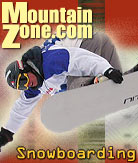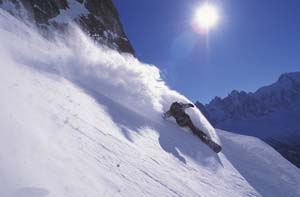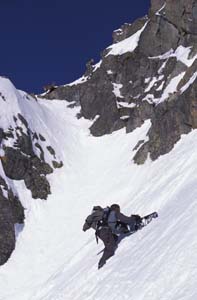
|
Athlete Profile: Steve Klassen A freeride legend... March 4, 2004
Pages »1 2
| ||||||||||||

|
|
| Klassen blasting a powder turn in Chamonix, France. Photo by Lucas Kane |
|
I think we'd all agree that snowboarding has gone through several phases since it's inception. It started with one-piece neon suits and over several years it has progressed into baggy pants and metal-studded belts. Some call it youth culture. Throw in a switch backside nine and most people would write it off as crazy kids on too much caffeine, or call it 'extreme.'
While these generalizations do represent a portion of the snowboard genre, there is another side to it that many of us rarely hear about. It isn't glorified in the magazines and it isn't quite so flashy, which ironically, is a great way to describe freeriding legend, Steve Klassen.
If you met him on the street, you'd never guess that he's helped shape the sport of snowboarding. He rarely talks about himself and he doesn't gloat in all his glory, but if you dig a little bit deeper, you'll find that he has all the reason to. One of his recent accomplishments, winning the 2003 Verbier Extreme, snowboarding's most illustrious freeride competition, could only be done by performing freestyle maneuvers while descending a 50 degree face in relatively low snow conditions. In fact, you'll find him on the podium at all the major freeriding events, but his contributions to the sport extend far beyond winning competitions.
Today, at 39 years of age, Klassen takes as many risks in business as he does on his board. While he remains a competitive snowboarder at the highest level, he's also the owner of Wave Rave snowboard shop in Mammoth Lakes, California and he recently began designing and manufacturing Steepwater Snowboards, a custom made line of freeride decks. Klassen has had an immense influence on the sport of snowboarding from the very beginning, and I find it refreshing to see someone who can lead the industry, both on and off the snow.
MZ: So Steve, the last time we rode together, I couldn't help but notice your boots. What kind of gear are you riding these days?
I'm on a Steepwater 171 Steep, old Burton boots from 1996, and I've got Burton X-base bindings. The bindings aren't true low-back bindings, but they're definitely two inches lower than what most people ride.
MZ: Do you find it at all ironic that the owner of Mammoth's biggest snowboard shop rides boots and bindings from almost a decade ago?
(Laughs) I like the softest boot I can find. I like to get the support out of my bindings, instead of my boots. I want to have as little material between my foot and my binding, and be as close to my board as possible. In fact, as I'm riding, I can curl my toes and grip my board through the bottom of my boots. When I'm walking on rocks, it's almost like walking barefoot the soles are so thin.

|
|
| Klassen earning his turns in Chamonix. Photo by Lucas Kane |
|
MZ: Where did you find Burton boots from 1996?
(Laughs) I bought a couple pairs on EBay so I have one pair for back up. I don't know what to say. I know what I want to ride and I don't want to make any sacrifices. In the past, I made the mistake of getting sponsored and had to ride gear that just didn't perform. A lot of pros probably deal with the same issue. I made that mistake once and I won't make it again. I'm going to ride what I want to ride and that's it.
MZ: So I'm assuming that's why you started Steepwater Snowboards - so you wouldn't have to rely on a board company to produce the board you want to ride?
Yeah, it was a need that myself and several other riders had for a certain type of board. I guess you could go back to the Rossignol days - I rode for them for seven years. At the time, they produced a board called "The Rocal" and it was the shape that I liked about it. What it did differently was it would plow through chopped up, hard snow and make it feel like it was smooth snow.
Then Rossignol went freestyle so the direction that I wanted to see boards go, didn't happen. At that point, it was matter of convincing another board company to do it, or doing it myself. So I got together with Paul Ferguson and we went for it ourselves.
MZ: And it's going well?
It's going good. It seems like every day there's a message on my answering machine with some guy freaking out about how it's exactly what he wants and how he hasn't been able to find this type of board until now. Next year, we'll probably sell about 400 boards out of approximately 50 shops.
MZ: While the majority of the industry is moving towards freestyle, do you find it hard to promote a freeride line of boards?
The shops are open to it because a lot of people want to freeride. That's what most of us do on a daily basis and what's interesting is that because everything freeride has gotten shoved into the corner, it's actually created an opportunity for us. There's no way that a snowboarder could start his own board company and compete within the freestyle market. And I'd say that as snowboarders get older, they want a board that makes it easier for them to ride challenging terrain.
MZ: Speaking of challenging terrain, describe your run at last year's Verbier Extreme freeride competition in Verbier, Switzerland.
Well, I tried to get through the top section fast and relaxed to conserve my energy. My run really started when I launched that first big (40ft) cliff. When I landed, I had a little more speed than I expected, but I was prepared for anything off of that first cliff so I was sure that I could clear the next rock band. At the bottom of the course there's a bit more room for freestyle, so I threw a corked seven off the next drop. The landing wasn't as clean as it could have been, so I stuck a back flip off the very last cliff, just before the finish line.
MZ: So you're 39 years old, you're competing against kids half your age (literally) and beating them, your boots are from 1996 and you run one of California's bigger snowboard shops. How do you maintain such a high level of riding?
With contests like that, it's pretty much an extension of what I do every day. It's just like in Mammoth when I'm riding the steeps. I get to the top of the lift, charge down the mountain, and jump off of as many cliffs as I can along the way. I've been riding for over 30 years. I don't think the younger guys have had as much time on the hill as I have and I see it more like a learned sport. As long as you stay uninjured, you can keep getting better and better with time.